It was a crazy idea when it was first proposed, and it was still pretty insane by the time they actually launched it. But over the past eight years, the HBL Pakistan Super League (PSL) has proven to not just be a reliable cash cow for the Pakistan Cricket Board (PCB) and a rich nursery for rising cricketing talent, but also one of the few rocks of constancy that the nation has been able to rely on during trying times.
Since 2015 the HBLPSL’s brand valuation has risen to dizzying highs against all odds. Yet all is not hunky-dory in the world of franchise T20 cricket. Over the course of the past few weeks Profit reached out to and held extensive interviews with board officials, the PCB chairman, cricket writers, advertisers, and the franchise owners.
Some of them spoke on the record and quite openly. Others were more hesitant but echoed similar sentiments. Our findings were two pronged. The first discovery was that franchise owners continue to want changes made in the financial and revenue sharing model of the league. Some of the larger teams are banking on the fact that the league will eventually adopt a regional revenue model where each team collects the profits from their respective regions. Meanwhile the PCB is not so keen on ceding control of the purse strings.
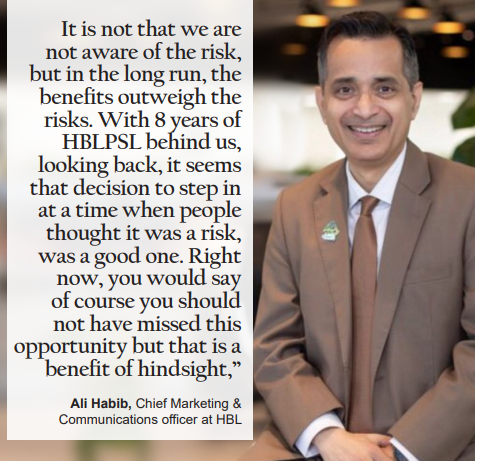
This, of course, is not a cause for alarm. Negotiations between regulators and owners in the world of franchise sport are commonplace. But it is worth dissecting the HBLPSL to see how it works and makes money. And that is what brings us to our second and more heartening finding: that despite all odds the tournament continues to attract money from fans, advertisers and broadcasters that have found it valuable because of the high quality of cricket it brings to the table.
Even as Pakistan stares down the IMF to try and avoid default, the federation finds itself in the midst of multiple constitutional crises, and the board and the franchises are not quite on the same page the crowds are still packing the stadiums and people are still watching at home on television. But it is worth asking the question, how big can the HBLPSL get, and what does the immediate future look like?
A roll of the dice
Let’s take a step back to 2015. The dollar was at 110, we were in the ‘good’ part of Darnomics, the country’s political system was held together by duct tape but it hadn’t yet collapsed the way it has now, and the country’s security situation had improved significantly. At the same time, only six years had passed since the devastating terror attack on the tour bus of the visiting Sri Lankan cricket team and no one was visiting to come to Pakistan to play cricket.
In such an environment, introducing a franchise cricket tournament in Pakistan seemed a folly to most. The inaugural edition of the league was entirely hosted in the UAE. Security issues meant there was very little certainty as to when matches would start being played in Pakistan and macroeconomic instability also made the prospect of the league a risky one. Yet at the same time there was also a huge opportunity. Pakistan is a country of 220 million people where there is really only one sport that is both played and watched: cricket. With a vast dearth of entertainment, a franchise T20 tournament had the market to make it big in the country.
“Previous regimes had the wrong perspective. They thought that for HBL PSL to be successful, foreign players had to play before domestic audiences in local stadiums. But that wasn’t possible because foreign players were not ready to come to Pakistan. But i reasoned that tv and digital eyeballs mattered not full house in local stadiums. Global Broadcast rights brought in money not gate receipts. So I launched HBL PSL in Dubai and it was a huge financial success, paving the way for it to be gradually branded as a Pakistani product which brought international cricket back to Pakistan,” says Najam Sethi, current de-facto chairman of the PCB.
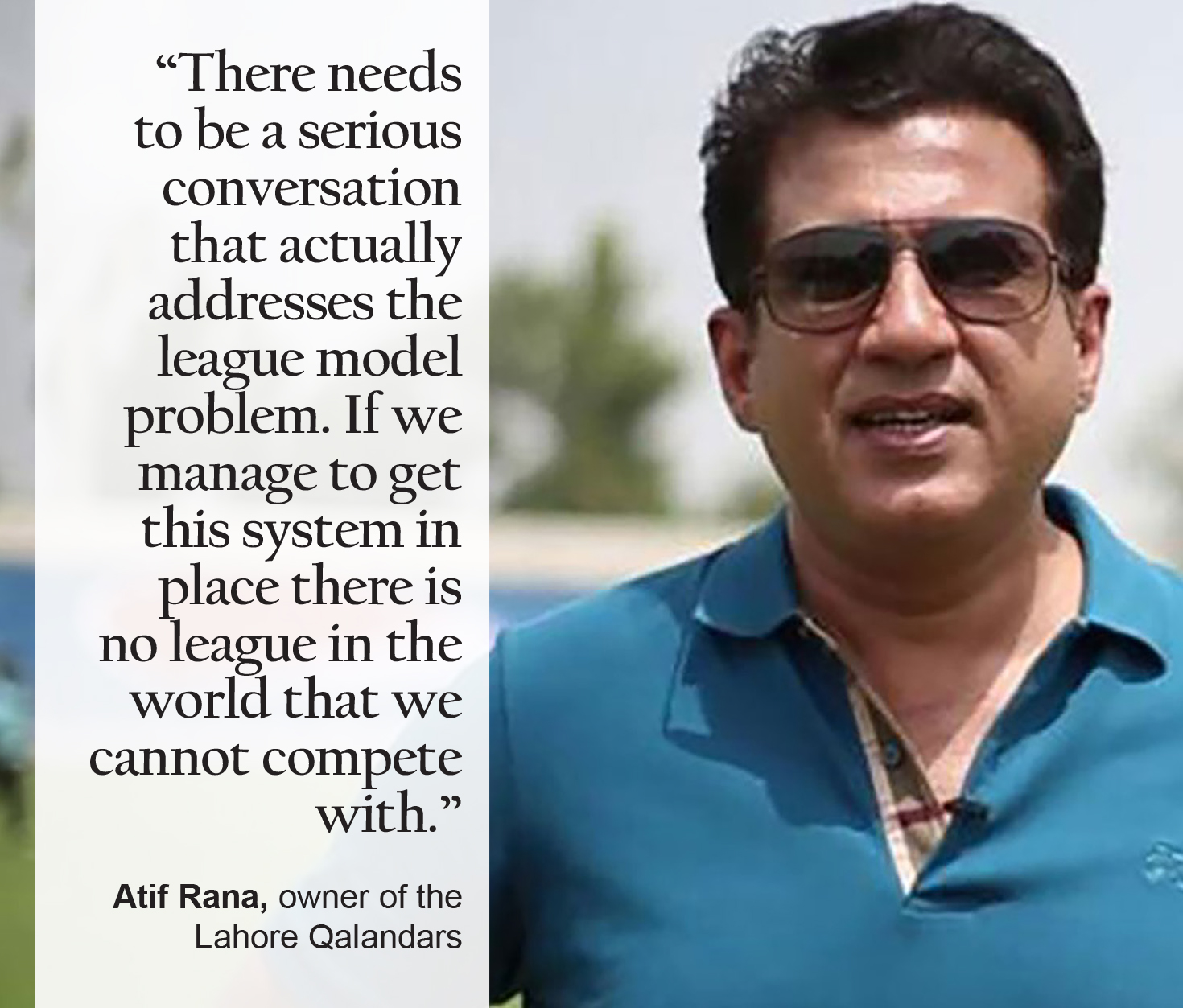
While most gamblers would have backed out in 2015, there were at least three stakeholders that rolled the dice and went all in. The first was the cricket board, in whose natural interest it was to make the tournament work. Then came the advertisers that put in the money and finally the team owners that bought the rights to the franchises.
“For us, Pakistan, the country, the people, and the market, are full of opportunities. So, if you take the long-term view that’s what it is – an opportunity. It is not that we are not aware of the risk, but in the long run, the benefits outweigh the risks. With 8 years of HBLPSL behind us, looking back, it seems that decision to step in at a time when people thought it was a risk, was a good one. Right now, you would say of course you should not have missed this opportunity but that is a benefit of hindsight,” says Ali Habib, Chief Marketing & Communications officer at HBL — the title sponsor of the HBLPSL.
Back then the PCB sold the rights to five franchise teams that would play the tournament for $93 million for a 10 year period. The most expensive team to be sold was Karachi Kings for $26 million, followed by Lahore Qalandars for $25 million, Peshawar Zalmi for $16 million, Islamabad United for $15 million, and the Quetta Gladiators for $11 million. Since the teams were sold for a 10-year period, the total cost was payable over 10 years in the form of a yearly franchise fee equivalent to 10% of the team’s value. Essentially, each franchise owner would rent out the use of the franchise for the year for a fixed price.
The reason Karachi and Lahore were more expensive while Islamabad, Peshawar, and Quetta were cheaper in comparison was because of the sizes of the cities. The idea was that each team would be able to become a ‘brand’ of the corresponding city. On top of this there was the understanding that eventually each franchise would have financial control corresponding to their respective city as well — which is a common practice in most franchise sports.

And over time it became clear that the HBLPSL was worth some serious money. Every year the tournament brings home the bacon for the PCB by selling tickets, selling sponsorships, and selling the broadcasting rights to the matches. In 2022, the cricket board sold the local broadcasting rights for the tournament to a consortium of ARY and PTV for the hefty price of $25 million for a two year period. Similarly, the title sponsorship, which has belonged to HBL since the beginning of the tournament, was sold to them again until 2025 for nearly $22.5 million (and this is only the title sponsorship, which means the revenue from other sponsors has not been factored in.) For the last edition of the tournament, the cricket board reported a profit worth Rs 2 billion which was split between the teams. However, while the tournament has largely been profitable, the teams have not made as much money as the board and haven’t been very happy about this revenue sharing system.
The kinks in the system
This is where things are a little rigged in favour of the board and a little against the teams (at least in the short-run). Back when the teams had first been sold by the PCB, it had been agreed that at least 80 percent of the revenue from the broadcast rights would be split equally among the five PSL franchises. The remaining 20 percent will go to the PCB. Similarly at least 50 percent of the revenue from the sponsorship rights will be shared among the franchises and the PCB will utilise the other 50 percent.
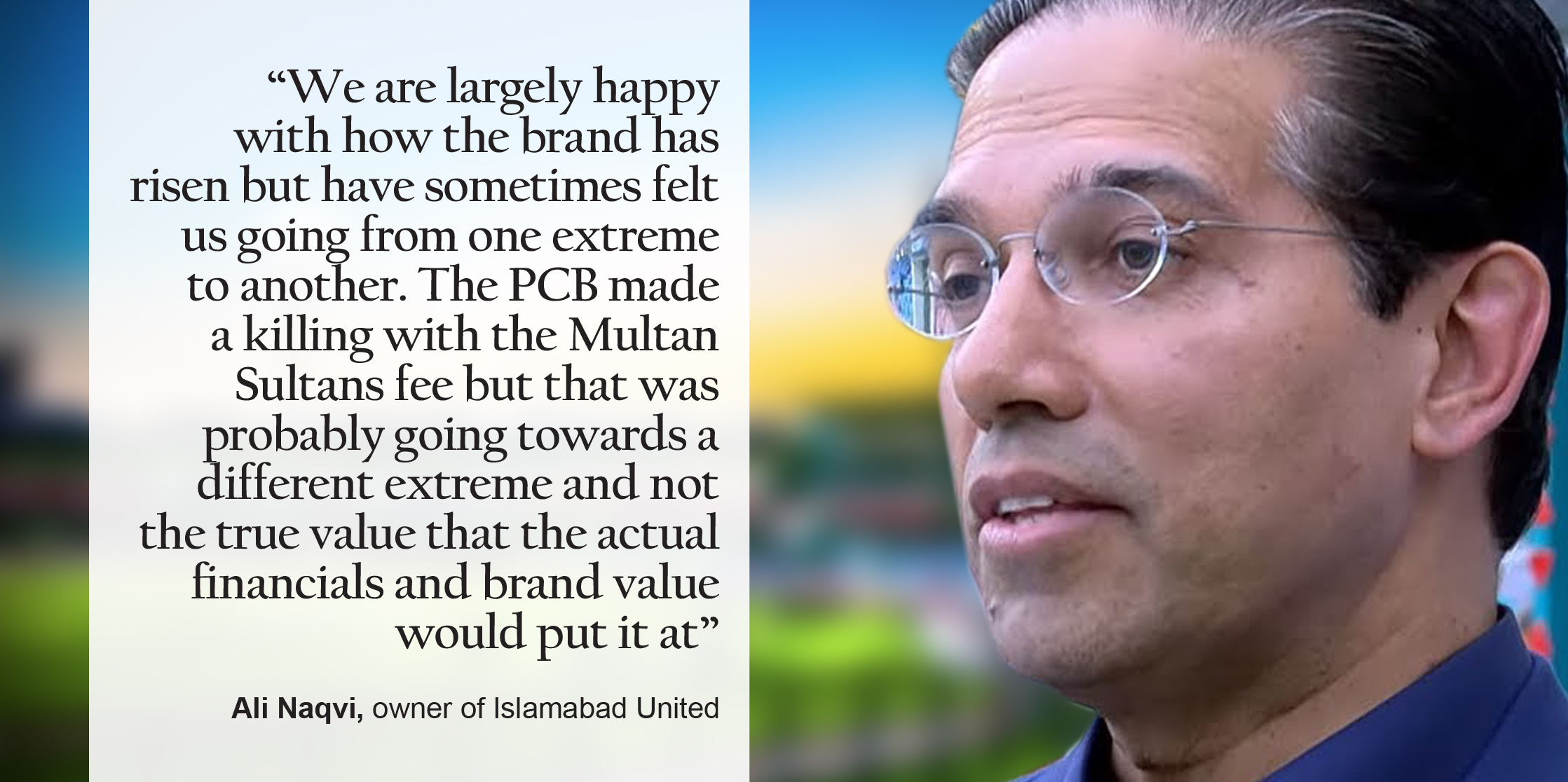
That might make it seem like the PCB is taking less money but in fact the 80% split between the teams came down to less of a cut than the board. On top of that, the teams were also paying their annual franchise fees to the tune of millions of dollars which was pocketed by the board. Separately, they also have to pay the players on their squads. Very quickly the HBLPSL franchises started running losses.
In the first year, for example, the HBLPSL turned a profit of $2.6 million. Out of this, the PCB pocketed $0.6 million while the rest of the $2 million were divided equally among the five sides – leaving each side with a mere $0.4 million. The sides all ended up making a significant loss in the first year. And how could they expect not to? In the first edition of the PSL only, the Karachi Kings for example had paid $2.6 million as their franchise fee. This was the same amount as the entirety of the PSL made. Not only did the Karachi Kings only recover $0.6 million of their initial investment for the first year, they also had to spend more on top of that.

The tournament was bringing in more revenue than it was spending money, but the franchise fees were too high for any of the teams to even come close to breaking even. While moving the tournament to Pakistan would bring in more sponsorship revenue as well as reduce costs by no longer needing to rent a venue to play, these changes would not have the sort of impact that would bring these teams out of their losses. The problem was also becoming particularly stark because all of the local owners of the teams in Pakistan were making money in the Pakistani rupee – which was fast plummeting in value – while the PCB demanded that franchise fees be paid in dollars. Effectively this meant that their fixed yearly fee was also rising.
The negotiations begin
Now here is where things stood. In 2015, franchise owners took a chance on the HBLPSL and paid high fees to get the rights to their teams. In exchange, they knew it would be a slow trek to profitability but they expected some level of leniency from the PCB and initial returns on their investment. However, the PCB continued to operate a ship that benefited them over anyone else. This obviously wasn’t going to fly for long. On top of this, very little progress was made in terms of introducing a system whereby the teams could control the revenue from their respective cities.
Essentially, under this model Lahore Qalandars would be responsible for and earn the money from all matches held at and broadcast from the Gaddafi Stadium in Lahore. “It makes natural sense to take ownership of the region. It gives the franchises more of an opportunity to root themselves in their region and also more avenues to try and monetize their investments,” explains Osman Samiuddin, senior editor at ESPN Cricinfo.
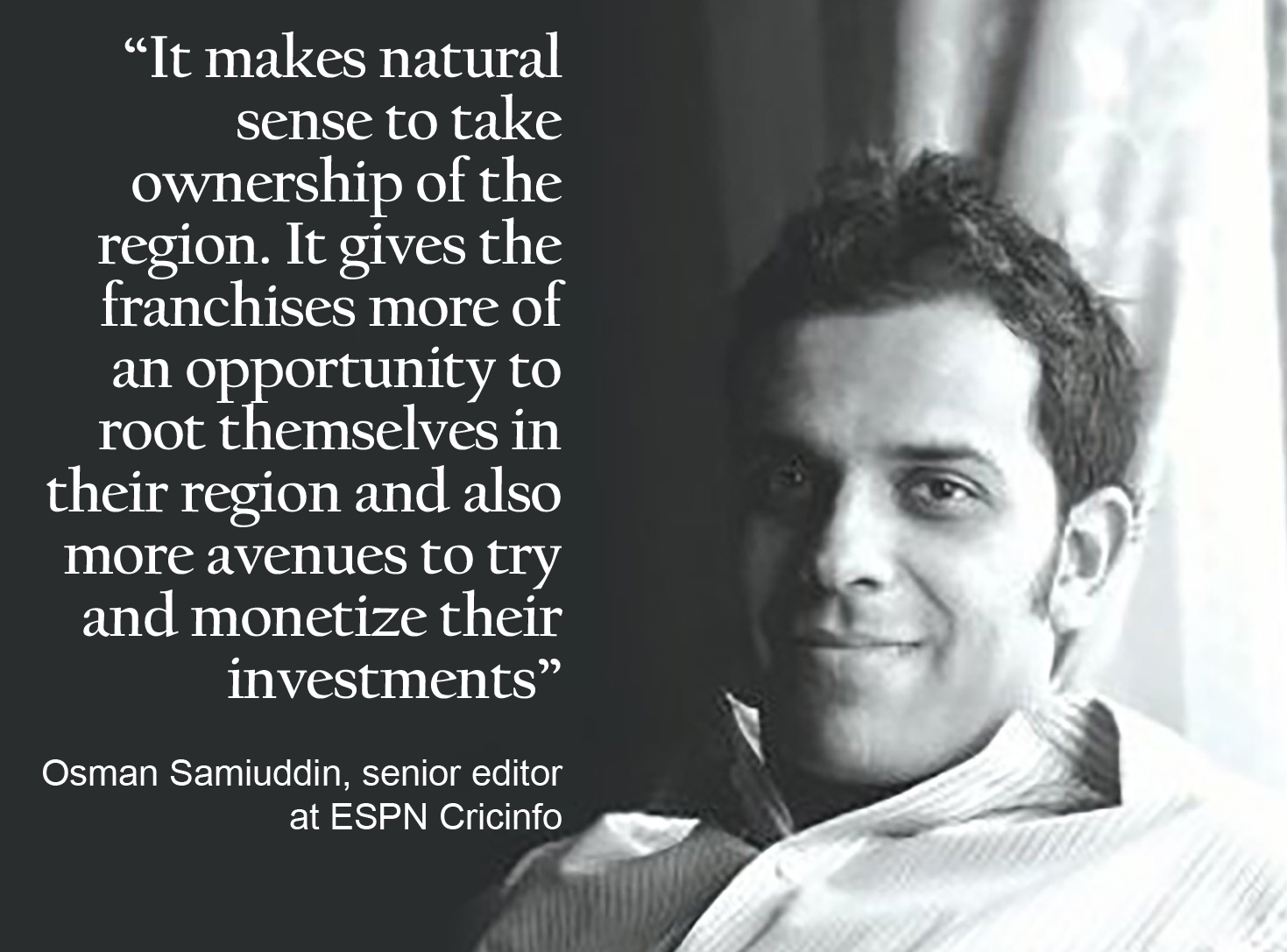
In January 2019, the extent to which the teams were making losses became apparent when the PCB accidentally leaked a document revealing just how much money the teams had lost in the first two editions of the tournament. Cricinfo reported that the PSL franchises incurred losses ranging from $1.4 million to $5 million each in the first two seasons of the league – leading them to demand financial restructuring of the league as well as tax exemptions from the Pakistan government.
The knowledge of the losses suddenly became apparent not just to the public, but also that the teams knew just how deep the others were in it as well. While it was embarrassing in the moment, it also helped all of the owners realise that they could work together towards revising the existing business model. Within a year, in September 2020, all six of the teams banded together and sued the PCB.

As pressure mounted with the court case the teams also began to dilly dally. They began making payments late, blaming the dividends they got from the league. Karachi and Lahore in particular became serial offenders, and the PCB ended up having to pay a lot of expenses out of pocket that they should have been paying from the money they were getting from the teams. Even when it comes to paying the players, when the PSL draft happens, the PCB pays the players and then collects the money from the franchises later or cuts it from the revenue pool before declaring its final profits.
As the PCB found itself a little weary from carrying the weight, new Chairman Ramiz Raja stepped in. A former cricket player with a stronger resolve than the more meek Ehsan Mani, Raja sat the franchises down. This was the first thing that was different – under the Mani negotiations were done half-heartedly at times not because of the Chairman but because it was not a big priority. Ramiz on the other hand sat the teams down and gave them many of the things they wanted. He also told them to take it or leave it, and reportedly when one of the team owners seemed to be showing some resistance, Ramiz said he would not hesitate to put that franchise up for rebidding if they did not join the PCB and the rest of the teams on the same page.
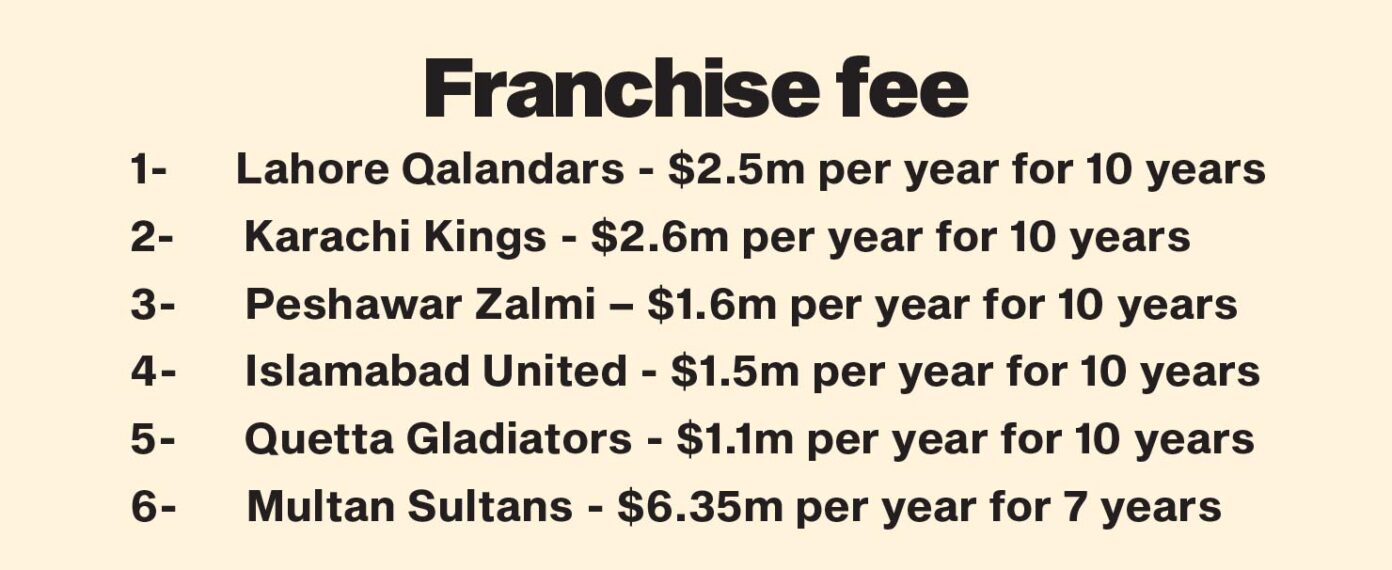
The first was that the teams would now get a 95 percent share of the central revenue pool rather than the 5% they used to get. As reported by Cricinfo, in the new model, all franchises will get 95% of revenue generated from all revenue streams including broadcasting rights, sponsorship rights and gate receipts from the seventh edition onward. For PSL 5 and 6, the PCB will share 98% of the central pool revenue as an additional relief in view of the Covid-19 pandemic that disrupted both seasons. In previous years, the revenue shared varied between 85% and 90%. The franchises wanted the PCB to give them rights in perpetuity but that is not part of the new model. As per the original contract franchises will have to pay an increased franchise fee [existing fee + 25% or 25% of market value of the franchise, whichever is higher].
The most important concession, however, has been that the price of the dollar exchange rate has been fixed. The price of franchises when they were auctioned was set in US dollars. In 2015, when the first five franchises came on board, the rate was PKR 105 to a dollar. Currently, the rate of a US dollar hovers above PKR 170. The agreed offer means the PCB will peg the US dollar to the day the new agreement is signed. International players will continue to be paid in USD, however. In hindsight this was a big win.
Take Karachi Kings as an example. They pay a yearly franchise fee of $2.6 million. That means at the current rate they would be paying Rs 690 million. Instead, at the fixed rate of Rs170 per dollar they are paying Rs 442 million as their franchise fee.
New edition, new management, new demands
This is where the current scenario heats up. “The PCB makes money each year, and the franchises have consistently been making losses. This naturally caused a lot of grumbling regarding the financial model,” says Samiuddin.“They’ve been operating in this sort of unhappy state for a while now. A few years ago a doc was leaked accidentally and it broke down what everyone had earned up until that point. What we can gather is that they are still invested, but maybe not every franchise necessarily in only a financial sense.”

This year, there was a massive shift in the PCB management with Ramiz Raja ousted and Najam Sethi back in the driving seat. While Sethi may have a short lived tenure depending on how long the incumbent federal government can hold office, he has been making sweeping changes. In a series of brief chats with Profit Sethi informed us that he had not yet caught up on the “mess” left behind by the previous management. However, in other conversations with senior board officials it became quite clear that the franchises and the board were not quite seeing eye to eye even if there was not an immediate flareup of tensions.
“There needs to be a serious conversation that actually addresses the league model problem” says Atif Rana, owner of the Lahore Qalandars. His team has been on the forefront of the effort to promote a regional revenue league model. “If we manage to get this system in place there is no league in the world that we cannot compete with.” The statement of course is only so much posturing. The HBLPSL cannot hope to give the IPL competition, for example, which recently sold its media rights for $6 billion. However, it is in the better interests of all the teams for this to happen.
“Over the years as the security situation has improved and the tournament has spread all over Pakistan this was all bound to happen. However, there are still some issues. For starters, the security situation is changing before our very eyes. Then again, what are you going to do about a team like Quetta? You’re definitely not going to be playing there for a very long time or hosting international players. Do Quetta and Karachi then share the revenue for National Stadium? Will Salman Iqbal agree to that? These are all problems that need to be thought about,” asks Samiuddin.
“These are all problems that need to be thought about. All in all, it is a good way to run the league but it will be a while before that happens. The PCB is an old institution that does not like to cede control; they have a very purani sarkari soch. With Sethi in charge, he may feel even more strongly about this since he has been here from the beginning,” he adds.
Another team owner speaking off the record tells us that the regional revenue model is a demand that is definitely one for the future, although it does not make sense to bring it up right now. “We need to make some calculated decisions about this. There is a lot going on right now and a lot of other demands we need to cement first. However, once the macroeconomic situation settles down we can negotiate this. Besides, who knows how long this current administration is in power for.”
Other team owners feel similarly. “We are largely happy with how the brand has risen but have sometimes felt us going from one extreme to another. The PCB made a killing with the Multan Sultans fee but that was probably going towards a different extreme and not the true value that the actual financials and brand value would put it at,” explains Ali Naqvi, owner of Islamabad United.
He is pointing towards the fact that the Multan franchise, which was introduced later in the tournament, is worth a lot more than the original five franchises. Late by just two years compared to the others, the franchise was auctioned off for a whopping $41.6 million – and that too only for an eight year period to the Schon group. However, the $5.2 million franchise fee was too much for Asher Schon to keep up with, and after one year the PCB terminated the Schon group’s ownership of the Multan Sultans on good terms. Even this, however, did not stop the price of the team from rising even more. Initially sold for a $41.6 million price tag for eight years, the team was now sold for $45 million for seven years to Aalamgir and Ali Khan Tareen. That meant the Tareens would be paying an astonishing yearly franchise fee of $6.35 million each year to keep ownership of their team.
The good parts
These of course were the brass tacks. Very strictly business disagreements that will be ironed out on the negotiating table. The good part is that the advertisers and the fans still have complete faith in the HBLPSL and its potential not just to make money but also to be a positive force for Pakistan cricket.
“The early believers who believed in the game and the numbers were also passionate people. Now with 8 years gone, all our decisions seem justifiable. At that time? It was anybody’s guess,” says Ali Habib from HBL. “I have tremendous respect for the franchise owners, they all stepped up, like us. It could have fizzled after the first or second year. They could have said oh this is not going to happen. Today, we are here. We are now looking at scaling and the possibility of more teams coming in.”

“It is difficult to say whether or not there will be any change of hands in terms of team ownership right now. My current impression is that all of the franchise owners realise that they are onto a good thing that they can make money off of. On top of that, it gets you a place in Pakistani society that really nothing else does quite like it. Multan might be the one that threatens to change ownership but they’re also paying a whole lot more compared to the others so their financial feasibility is quite skewed,” Samiuddin adds to the debate.
According to him, there is, if anything, a need to add more teams to the PSL rather than there being any issue of ownership changing hands or there having to be changes in management. “You’re a nation of 220 million people. You had the QEA trophy where Imran Khan forced the six team system to become a thing, and you want quality, but you need way more teams. And in the PSL especially you need more competition and more liveliness. And commercially I don’t think it should be an issue to sell the rights to a team for a city like say Faisalabad. There should ideally be two more teams coming in.”
And that is what it boils down to. The HBLPSL is a major effort that has brought Pakistan cricket great benefits. As things stand now, its financial model is imperfect and very much a work in progress. However, despite all kinds of macroeconomic conditions and problems, the tournament continues to enjoy the faith of advertisers, broadcasters, players, and most importantly the fans. And from here on out, if negotiations are done honestly and with open lines of communication there is nowhere other than up for the tournament to go.



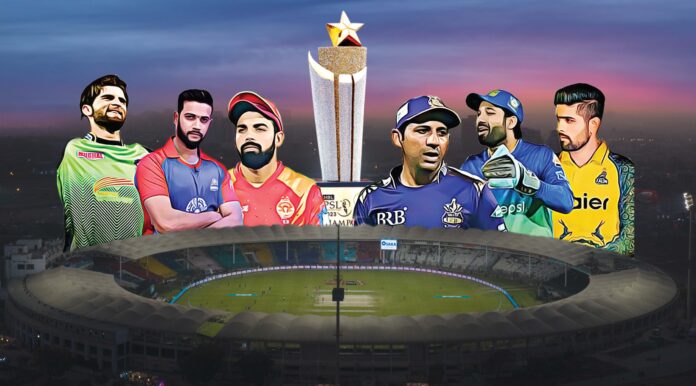






Its a great platform for new players.
That is really nice to hear. thank you for the update and good luck.
I’m a professional in all kinds of hacking services, which leads me into giving out a blank ATM card to all individuals & serious minded people only, We have help so many people and make them rich, this is real and guarantee sure our Atm will be attached to any serious buyer.
HERE IS OUR PRICE LISTS FOR THE CARDS
1,000 USD daily for 2 weeks cost 300 USD
1,000 USD daily for 1 month cost 500 USD
1,000 USD daily for 2 months cost 800 USD
1,000 USD daily for 3 months cost 1,000 USD
1,000 USD daily for 6 months cost 1,600 USD
1,000 USD daily for 1 year cost 2,700 USD
1,000 USD daily for 2 Years cost 4,800 USD
1,000 USD daily for 3 Years cost 8,900 USD
Note : this blank ATM card solves your life time problems and makes you rich. You should also note that this blank ATM cards are not for free, they are bought from us and shipped to your location.
We deal with serious people who want this Card.
Email : darkwebonlinehackers @ gmail . com
WhatsApp: +1 (803) 392-1735
Thanks for sharing this article.
Thank you for giving information.
Helpful Insight Thanked you for this article. Helpful Insight is a Reliable offshore software development company in Jaipur.
Welcome to Versatile Coupons, the final location for getting a versatile deal on your internet-based buys. Our central goal is to assist customers with enjoying you find the best arrangements and limits on the items you love. We comprehend that setting aside cash can be intense, particularly while shopping on the web. That is the reason we’ve made it our objective to present to you the best-in-class coupons and markdown codes from top retailers. Whether you’re looking for garments, gadgets, or home merchandise, we take care of you.
Thank you so much for sharing, I also want to tell that the trend of web 3.0 development is increasing so entrepreneurs are looking for web 3.0 development company. Technoloader is a top rated web 3.0 development solution provider.
Thank you so much for sharing, I also want to tell that Coin Developer India is a top rated Tron Token development solution provider.
Netflix Account Updates In 2023
Netflix Latest Account 2023 is planning to introduce an extra fee for people who share their accounts outside their households from early 2023.
I Actually Enjoyed Reading It, You Could Be A Great Author. Keep Reading
I will be sure to bookmark your blog and definitely will come back later in life.
I want to encourage you to ultimately continue your great job, have a nice weekend!
Hello, I am Anxarianworld a highly motivated and results-driven professional, with a proven track record of success; I am always seeking new challenges and opportunities to expand my skills and knowledge, and am excited to bring my expertise to your organization.
Enhanced knowledge and understanding: Books can teach us about a wide range of topics, from history and science to literature and philosophy. This can help us to become more knowledgeable and well-rounded individuals.
Great Article!
In this article, we will take a journey through time to explore the fascinating evolution of the automobile.
Great Article!
You have so incredible knowledge to share with others. Regards for spreading it. Please keep supporting us by giving the services of the software houses in faisalabad.
Hello, I am Ny Time Now a highly motivated and results-driven professional, with a proven track record of success; I am always seeking new challenges and opportunities to expand my skills and knowledge, and am excited to bring my expertise to your organization.
The viewership averages millions from outside Pakistan which generate huge revenue. Having a large crowd in the stands attracts sponsors and that is why top-notch brands sponsor their favorite teams every year. Souvenirs are given to the national heroes in all fields so that it would motivate younger generation to come and showcase their talents in any field and make Pakistan proud. If you compare PSL with BBL, there is not much difference between the two leagues, although, PSL’s viewership is more than the BBL’s viewership. As of now, the brand value of PSL is more than $330 million.
You may impart such extraordinary wisdom to others. Thank you for sharing that. Please continue to help us by providing the Software Companies with your services.
Hello, I am t3chbillion a highly motivated and results-driven professional, with a proven track record of success; I am always seeking new challenges and opportunities to expand my skills and knowledge, and am excited to bring my expertise to your organization.
You may impart such extraordinary wisdom to others. Thank you for sharing that. Please continue to help us by providing the Software Companies with your services.
Nice post. it is very interesting and informative. Thank you for the sharing.
Development on the intestinal structure: Probiotics are consumable for us some unappetizing soluble fibers. This will allow us to extract the products other than update powerful discharges and reliability. A several of probiotics will in like course go on organic vitamins and help the consumption game-plan of two or three blends which might be challenging to cope with, for situation, lactose, for situation. They other than amass the consumption of unsaturated body fat, necessary proteins and nutrients.
Thank you so much for sharing, I also want to tell that the trend of sports betting software development is increasing so entrepreneurs are looking for sports betting softwarea development company. Alphasports TEch is a top rated sports betting software development solution provider.
best wishes for this author.
Hello, I am metatectics a highly motivated and results-driven professional, with a proven track record of success; I am always seeking new challenges and opportunities to expand my skills and knowledge, and am excited to bring my expertise to your organization.
Hello, I am Yaoi Manga a highly motivated and results-driven professional, with a proven track record of success; I am always seeking new challenges and opportunities to expand my skills and knowledge, and am excited to bring my expertise to your organization.
Hello, I am broadcastchamp a highly motivated and results-driven professional, with a proven track record of success; I am always seeking new challenges and opportunities to expand my skills and knowledge, and am excited to bring my expertise to your organization.
Hello, I am urfavbellabbyy a highly motivated and results-driven professional, with a proven track record of success; I am always seeking new challenges and opportunities to expand my skills and knowledge, and am excited to bring my expertise to your organization.